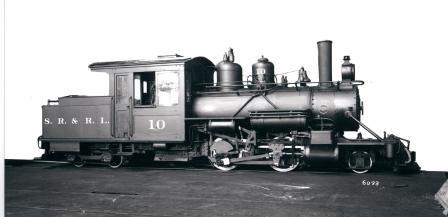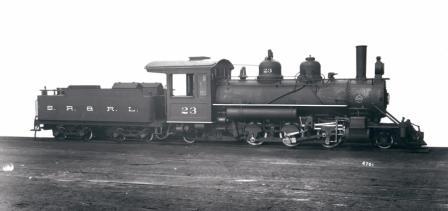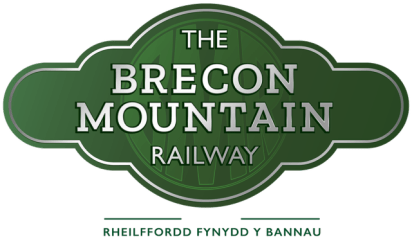NO.1 'SANTA TERESA' LOCOMOTIVE
No.1 was built by Baldwin of Philadelphia, USA in 1897 (No 15511) as a 2-6-0 tender locomotive for the Mogyana Railway in Brazil. It was sold by them to the Santa Teresa Sugar Mill, where it was converted to 2′-6′ gauge.
Out of use in 1976 it was brought to the UK in 1990. Restoration and re-gauging back to 1′-113/4” was started but carried out to a very poor standard and subsequently abandoned.
The locomotive was purchased by BMR in 2002. The loco has been completely rebuilt retaining the original Cylinders, Main Frame, Valve Gear and some of the Running Gear. The loco has been converted from a 2-6-0 to a 2-6-2. The boiler, smokebox, cab, wheels, axles, rear subframe, rear truck, front pilot and new tender have all been built in our workshops here at Brecon Mountain Railway. Santa Teresa No 1 came into service at Brecon Mountain Railway in June 2019.
Current update: No.1 is now back in service and is hauling all of the Santa Special trains!
NO.2 BALDWIN LOCOMOTIVE
No.2 was built by Baldwin of Philadelphia, USA in 1930, (No. 61269) for the Eastern Province Cement Co. Port Elizabeth, South Africa where it spent all its working life hauling limestone.
In 1973 it ran away driverless de-railed and was wrecked. It was treated as an accident write-off by the South African insurers and was purchased by us as salvage.
Shipped back to the UK as deck cargo to Liverpool, rebuilt here between 1993 and 1997 this 4-6-2 tender locomotive weighs 47 tons and is capable of hauling the heaviest trains to Torpantau.
Current Update – operational – July 2024
NO.3 FORNEY TYPE LOCOMOTIVE

Another long term project is the construction of this new locomotive which we are building from the original Baldwin drawings of the Sandy River and Rangeley Lakes Railroad, Maine, USA No. 10. The original was Baldwin No.44231. This 2-4-4 Forney type tank locomotive, weighing 33 tons, was originally built in 1916 and scrapped on closure of the railroad in 1936.
The frames and cylinders have now been erected, the driving wheelsets, front and rear trucks are complete, the rolling chassis is now complete. The boiler is temporarily in the frames, and is having various fittings and controls constructed. The work is now ongoing in front of the viewing gallery so progress is easy to see.
Over the foreseeable future the cab will be constructed and various other parts manufactured. Work in progress!!
NO.4 SANDY RIVER LOCOMOTIVE

A long term project is the construction of this new locomotive which we are building from the original Baldwin drawings of the Sandy River and Rangeley Lakes Railroad, Maine USA No. 23. This 2-6-2 heavy tender locomotive, weighing 53 tons, was originally built in 1913 and scrapped on closure of the railroad in 1936.
Many parts are already made, the tender is complete to footplate level and the loco bogies, motion, spring gear, brake gear and boiler fittings are finished. The next task is to cast and machine the cylinders and erect the mainframes.
This project is ‘on hold’ whilst the Forney is progressing.
DIESEL LOCOMOTIVES
Our smaller diesel is BMR 0-6-0DH (1/1987), built from Baguley Drewry parts here at the railway. The loco is used extensively for works trains. A sister loco was also built and is now in use at the Vale of Rheidol Railway
The larger loco, capable of pulling a full train up the steep gradients to Torpantau, is TU7 1698. This is a 400 H.P. Bo-Bo Diesel Hydraulic Locomotive.
OTHER LOCOMOTIVES
Pendyffryn
An 0-4-0 vertical boiler loco, built by De Winton & Co of Caernarfon in 1897, again for the Pen-Yr-Orsedd Slate Quarry.
Purchased in 1965 and put into store, a full restoration was completed by the railways workshops in 2012.
In early 2024 the loco was moved to the Vale of Rheidol Railway and is on-loan to them and displayed in their new museum.
Redstone
An 0-4-0 vertical boiler loco, built by Mr Redstone, a foreman fitter for the Penmaenmawr Granite Quarry as a 2ft gauge model of the 3ft gauge De Winton loco’s used in the quarry. This was built for the Quarry owners children in 1903 for use on a garden railway agound their house. Used at Trefor Quarry near Porthmadog in the1920’s.
Purchased in 1973 and put into store. A full restoration to working order was completed by the railways workshops in 2012.
In early 2024 the loco was moved to the Vale of Rheidol Railway and is on-loan to them and displayed in their new museum.
Sybil
An 0-4-0 saddle tank loco, built by Hunslet Engine Co. of Leeds in 1903, works No.827 and used at the Pen-Yr-Orsedd Slate Quarry, Nantlle near Caernarfon in N. Wales for all its working life until 1959. Purchased by Tony Hills in 1963, and rebuilt at his home in Knowle
Purchased in 1963 and rebuilt, it was used to haul the first trains here in 1980, hauling 1 carriage. Not used since 1981 the locomotive was fully restored in 2012 with extensive work carried out on the boiler.
The loco was sold in 2021 and is now in use at the Richmond Light Railway in Kent.
Arn Jung – ‘Graf Schwerin – Lowitz’
This locomotive was built by Arn Jung of Germany in 1908 (No. 1261) and came to the UK from The Mecklenburg – Pommersche Schmalspurbahn in East Germany.
It is an 0-6-2 well tank locomotive with a 4 wheel tender. Arriving here in worn out condition, it was completely rebuilt and has worked trains since 1981. Fitted with a new boiler, built in the railway’s workshops in 1993 it has covered extensive mileage in service here, until the line was extended to Torpantau. The loco was too small to operate all trains beyond DolyGaer so it was sold to the Vale of Rheidol railway and is now on display in their museum.
